Opinion & Analysis
Use statistics to improve your practice and achieve your golf goals
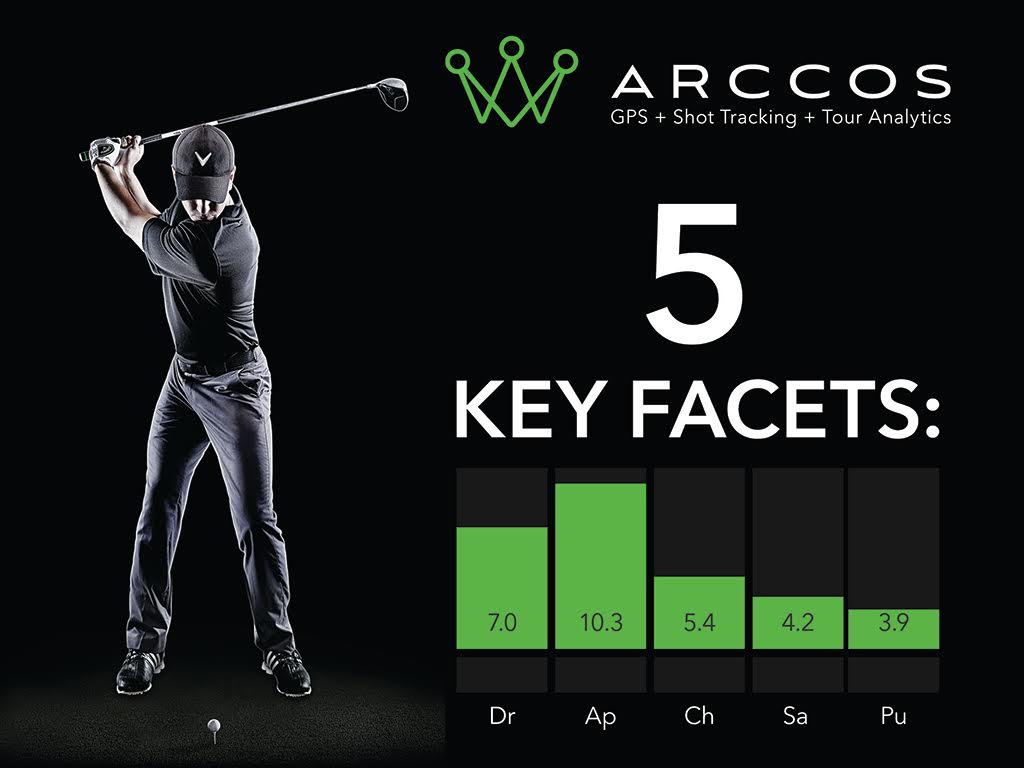
Ben Larsen is a contributor to GolfWRX, and Strategic Content Manager at Arccos Golf, the game’s first fully-automatic performance-tracking system.
Game. Improvement.
Those are perhaps the two most important words in the game of golf. If you’re not trying to improve, you’re just not trying. While there is undoubtedly a percentage of golfers who are “happy” with the levels they’re playing at, a large majority of golfers are endlessly working on their games.
From early-morning hours on the practice tee to weekly lessons with a PGA Professional (and the countless time spent off the course obsessing about all things golf), game improvement for you, me and tour pros never ends.
[quote_box_center]”Every week, we’re all trying to get better,” said Billy Horschel, a three-time winner on the PGA Tour and reigning FedExCup champion. “There is always something to work on, fix, tweak or improve on. With the amount of time we spend on our games, it’s important also to be working on the right parts of our games.”[/quote_box_center]
Clearly, the name of the game is improvement. But what are golfers to improve on? Better yet, what facets of their game should they be focusing on?
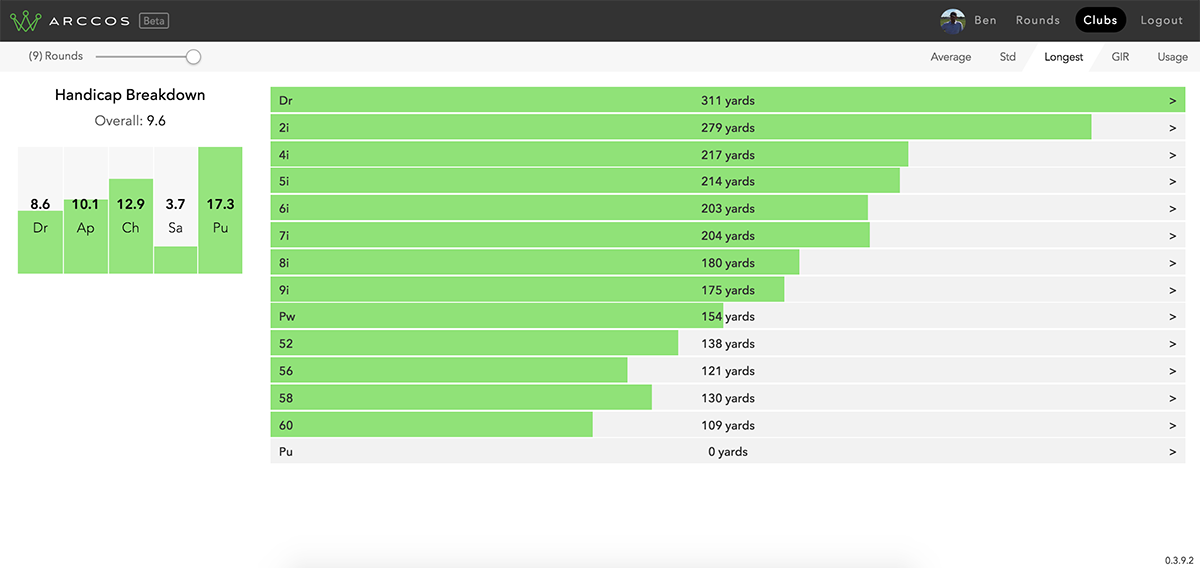
Do you really need a 4 iron? Arccos tracks your usage, average distances, and longest distances with each club.
It first begins with tracking. To assess your golf game, you should be tracking it. Whether it’s with an app, product, spreadsheet or pen and paper, documenting your game and generating data is the first step in the right direction.
[quote_box_center]
“For Tour pros, the competition is so good each and every week that we’re looking for an edge, however small it might be,” Horschel said. “That may mean identifying a trend that is leading to poor performance in your game, then focusing your practice time on fixing it.
“This can quite literally be the difference between recording a top finish or heading home for the weekend. It could even be the key to winning a tournament.”
[/quote_box_center]
The thing is, there is so much room for error in golf. With so many ways to improve, it can also be hard pinpointing what you should be working on. With that, we at Arccos break down the key stats and insights by category — across the five key facets of the game — you can generate from tracking your stats to make it easy for you to identify the areas most in need of improvement.
Driving
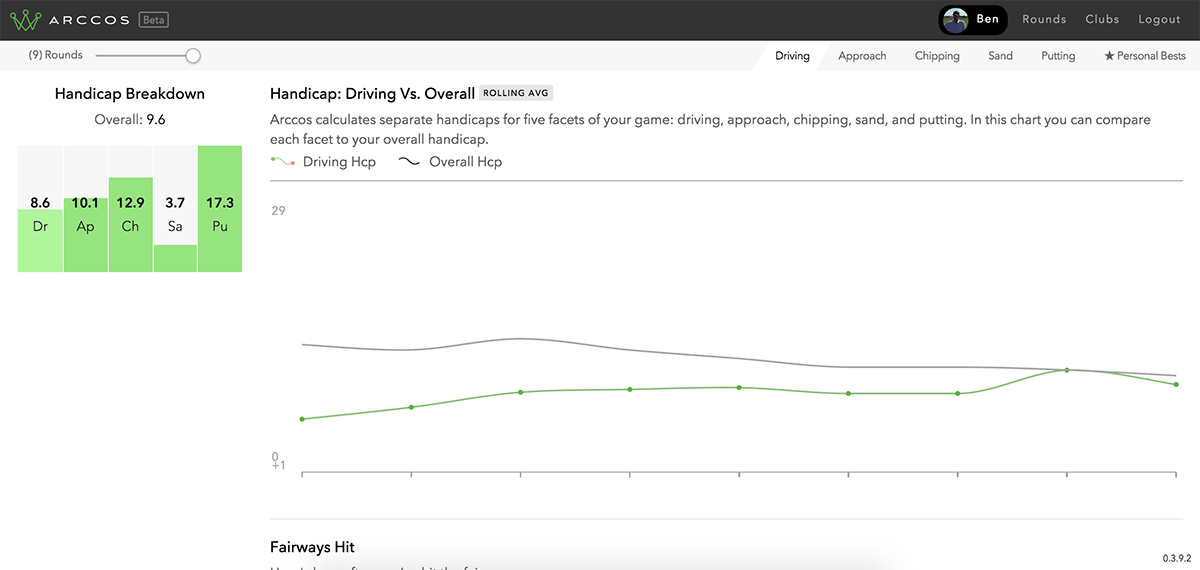
He might think he’s struggling with his driving (8.6 handicap), but the real key to improvement for this golfer is better putting (17.3 handicap).
Average driving distance, longest drive and standard deviation are all quantifiable stats that help you understand the consistency of your swings off the tee. Tracking your drives can also provide percentages on fairways hit and missed, along with whether you tend to miss left or right.
Approach
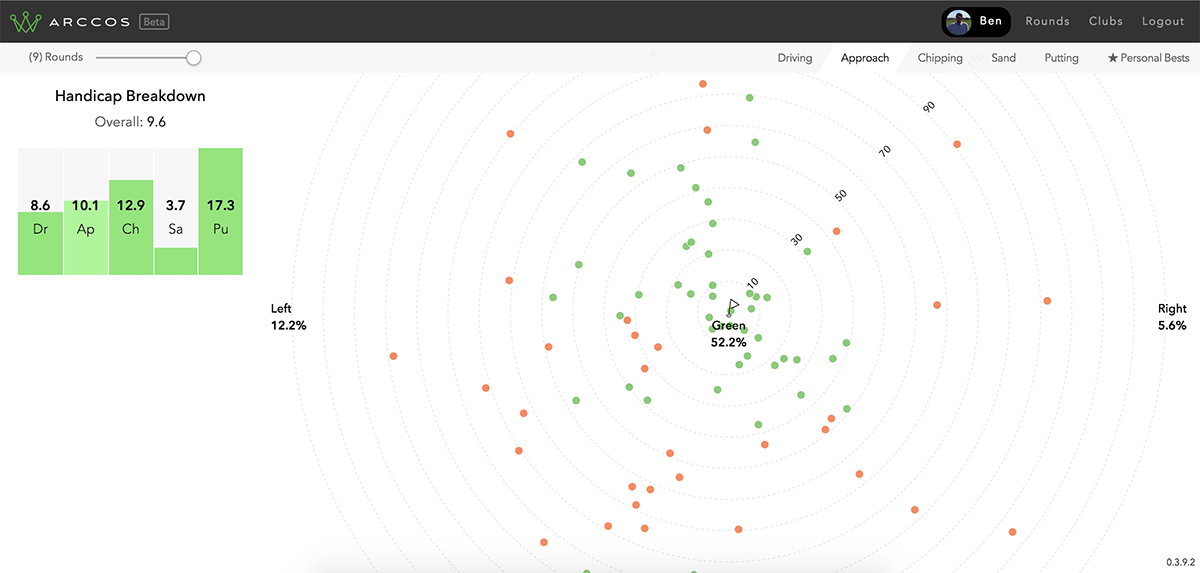
When this golfer misses the green, he tends to miss it to the left.
The most popular stat in the approach game is certainly greens in regulation. Surely, improving GIR will lead to more birdie opportunities, thus likely lowering your score. That said, it’s important to dive even deeper into your approach play. For instance, tracking your performance allows you to generate statistics like distance to pin on greens hit, distance to pin on all approaches, misses left and right and misses short or long. For those of us short on the majority of missed greens, improving GIR and your game may be as simple as choosing the right club. Tracking stats and identifying trends will help you do that.
Chipping
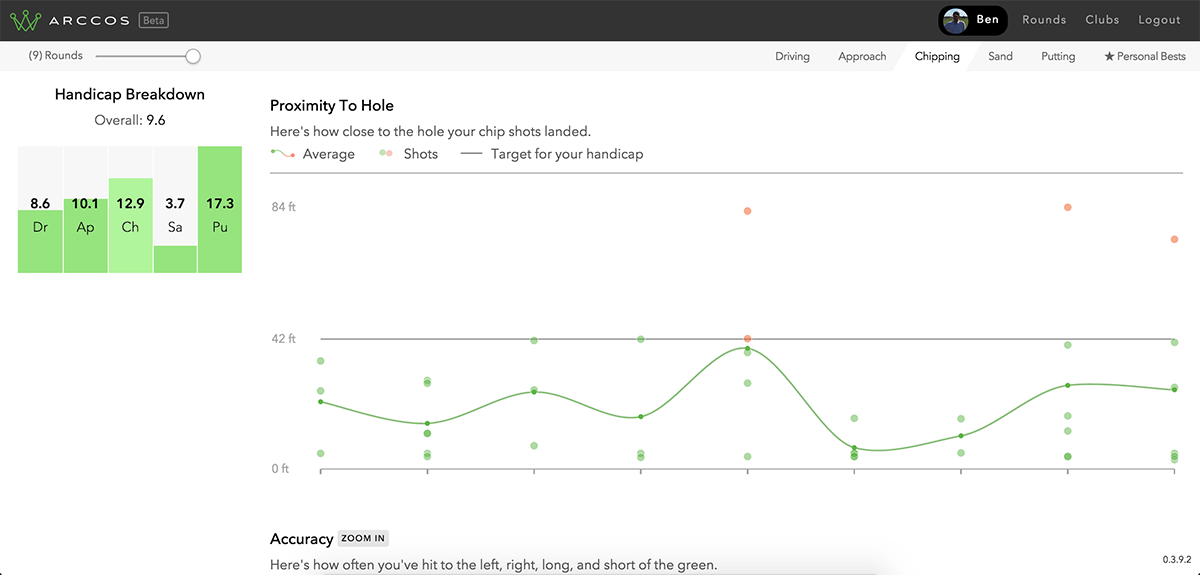
Are your chip shots as close to the hole as they should be for your handicap?
Ask any tour pro and they’ll agree. Around the greens is where the money is made — and lost. When tracking your short game, focus on your chip-and-down percentage, which quantifies how often you need only one putt to finish a hole after a chip. Another key stat to help dial in your short game practice is average distance to pin on chips. For instance, if your putting is suffering, it may not be your putting stroke. You may need to work on getting the ball closer to the hole when off the green.
Sand
Like chipping, sand play is incredibly important when trying to save par or limit a blowup hole. Similarly, sand-and-down and average distance to the pin on sand shots can really help unlock some understanding of your play from the bunkers.
Putting
Understanding your putting performance is perhaps the most important piece to game improvement. So many shots are lost or gained, rounds made or broken, with the putter. To dial into your putting performance, monitor putts per hole, putts after GIR and your percentage of one-putts. That will help identify if your putting woes are caused by a poor stroke, not giving yourself a chance to make putts or a combination of the two.
- LIKE55
- LEGIT11
- WOW1
- LOL2
- IDHT4
- FLOP6
- OB2
- SHANK16
19th Hole
Vincenzi’s 2024 Zurich Classic of New Orleans betting preview

The PGA TOUR heads to New Orleans to play the 2023 Zurich Classic of New Orleans. In a welcome change from the usual stroke play, the Zurich Classic is a team event. On Thursday and Saturday, the teams play best ball, and on Friday and Sunday the teams play alternate shot.
TPC Louisiana is a par 72 that measures 7,425 yards. The course features some short par 4s and plenty of water and bunkers, which makes for a lot of exciting risk/reward scenarios for competitors. Pete Dye designed the course in 2004 specifically for the Zurich Classic, although the event didn’t make its debut until 2007 because of Hurricane Katrina.
Coming off of the Masters and a signature event in consecutive weeks, the field this week is a step down, and understandably so. Many of the world’s top players will be using this time to rest after a busy stretch.
However, there are some interesting teams this season with some stars making surprise appearances in the team event. Some notable teams include Patrick Cantlay and Xander Schauffele, Rory McIlroy and Shane Lowry, Collin Morikawa and Kurt Kitayama, Will Zalatoris and Sahith Theegala as well as a few Canadian teams, Nick Taylor and Adam Hadwin and Taylor Pendrith and Corey Conners.
Past Winners at TPC Louisiana
- 2023: Riley/Hardy (-30)
- 2022: Cantlay/Schauffele (-29)
- 2021: Leishman/Smith (-20)
- 2019: Palmer/Rahm (-26)
- 2018: Horschel/Piercy (-22)
- 2017: Blixt/Smith (-27)
2024 Zurich Classic of New Orleans Picks
Tom Hoge/Maverick McNealy +2500 (DraftKings)
Tom Hoge is coming off of a solid T18 finish at the RBC Heritage and finished T13 at last year’s Zurich Classic alongside Harris English.
This season, Hoge is having one of his best years on Tour in terms of Strokes Gained: Approach. In his last 24 rounds, the only player to top him on the category is Scottie Scheffler. Hoge has been solid on Pete Dye designs, ranking 28th in the field over his past 36 rounds.
McNealy is also having a solid season. He’s finished T6 at the Waste Management Phoenix Open and T9 at the PLAYERS Championship. He recently started working with world renowned swing coach, Butch Harmon, and its seemingly paid dividends in 2024.
Keith Mitchell/Joel Dahmen +4000 (DraftKings)
Keith Mitchell is having a fantastic season, finishing in the top-20 of five of his past seven starts on Tour. Most recently, Mitchell finished T14 at the Valero Texas Open and gained a whopping 6.0 strokes off the tee. He finished 6th at last year’s Zurich Classic.
Joel Dahmen is having a resurgent year and has been dialed in with his irons. He also has a T11 finish at the PLAYERS Championship at TPC Sawgrass which is another Pete Dye track. With Mitchell’s length and Dahmen’s ability to put it close with his short irons, the Mitchell/Dahmen combination will be dangerous this week.
Taylor Moore/Matt NeSmith +6500 (DraftKings)
Taylor Moore has quickly developed into one of the more consistent players on Tour. He’s finished in the top-20 in three of his past four starts, including a very impressive showing at The Masters, finishing T20. He’s also finished T4 at this event in consecutive seasons alongside Matt NeSmith.
NeSmith isn’t having a great 2024, but has seemed to elevate his game in this format. He finished T26 at Pete Dye’s TPC Sawgrass, which gives the 30-year-old something to build off of. NeSmith is also a great putter on Bermudagrass, which could help elevate Moore’s ball striking prowess.
- LIKE7
- LEGIT3
- WOW1
- LOL1
- IDHT0
- FLOP3
- OB1
- SHANK1
19th Hole
Vincenzi’s 2024 LIV Adelaide betting preview: Cam Smith ready for big week down under

After having four of the top twelve players on the leaderboard at The Masters, LIV Golf is set for their fifth event of the season: LIV Adelaide.
For both LIV fans and golf fans in Australia, LIV Adelaide is one of the most anticipated events of the year. With 35,000 people expected to attend each day of the tournament, the Grange Golf Club will be crawling with fans who are passionate about the sport of golf. The 12th hole, better known as “the watering hole”, is sure to have the rowdiest of the fans cheering after a long day of drinking some Leishman Lager.
The Grange Golf Club is a par-72 that measures 6,946 yards. The course features minimal resistance, as golfers went extremely low last season. In 2023, Talor Gooch shot consecutive rounds of 62 on Thursday and Friday, giving himself a gigantic cushion heading into championship Sunday. Things got tight for a while, but in the end, the Oklahoma State product was able to hold off The Crushers’ Anirban Lahiri for a three-shot victory.
The Four Aces won the team competition with the Range Goats finishing second.
*All Images Courtesy of LIV Golf*
Past Winners at LIV Adelaide
- 2023: Talor Gooch (-19)
Stat Leaders Through LIV Miami
Green in Regulation
- Richard Bland
- Jon Rahm
- Paul Casey
Fairways Hit
- Abraham Ancer
- Graeme McDowell
- Henrik Stenson
Driving Distance
- Bryson DeChambeau
- Joaquin Niemann
- Dean Burmester
Putting
- Cameron Smith
- Louis Oosthuizen
- Matt Jones
2024 LIV Adelaide Picks
Cameron Smith +1400 (DraftKings)
When I pulled up the odds for LIV Adelaide, I was more than a little surprised to see multiple golfers listed ahead of Cameron Smith on the betting board. A few starts ago, Cam finished runner-up at LIV Hong Kong, which is a golf course that absolutely suits his eye. Augusta National in another course that Smith could roll out of bed and finish in the top-ten at, and he did so two weeks ago at The Masters, finishing T6.
At Augusta, he gained strokes on the field on approach, off the tee (slightly), and of course, around the green and putting. Smith able to get in the mix at a major championship despite coming into the week feeling under the weather tells me that his game is once again rounding into form.
The Grange Golf Club is another course that undoubtedly suits the Australian. Smith is obviously incredibly comfortable playing in front of the Aussie faithful and has won three Australian PGA Championship’s. The course is very short and will allow Smith to play conservative off the tee, mitigating his most glaring weakness. With birdies available all over the golf course, there’s a chance the event turns into a putting contest, and there’s no one on the planet I’d rather have in one of those than Cam Smith.

Louis Oosthuizen +2200 (DraftKings)
Louis Oosthuizen has simply been one of the best players on LIV in the 2024 seas0n. The South African has finished in the top-10 on the LIV leaderboard in three of his five starts, with his best coming in Jeddah, where he finished T2. Perhaps more impressively, Oosthuizen finished T7 at LIV Miami, which took place at Doral’s “Blue Monster”, an absolutely massive golf course. Given that Louis is on the shorter side in terms of distance off the tee, his ability to play well in Miami shows how dialed he is with the irons this season.
In addition to the LIV finishes, Oosthuizen won back-to-back starts on the DP World Tour in December at the Alfred Dunhill Championship and the Mauritus Open. He also finished runner-up at the end of February in the International Series Oman. The 41-year-old has been one of the most consistent performers of 2024, regardless of tour.
For the season, Louis ranks 4th on LIV in birdies made, T9 in fairways hit and first in putting. He ranks 32nd in driving distance, but that won’t be an issue at this short course. Last season, he finished T11 at the event, but was in decent position going into the final round but fell back after shooting 70 while the rest of the field went low. This season, Oosthuizen comes into the event in peak form, and the course should be a perfect fit for his smooth swing and hot putter this week.

- LIKE12
- LEGIT3
- WOW1
- LOL1
- IDHT0
- FLOP1
- OB1
- SHANK1
Opinion & Analysis
The Wedge Guy: What really makes a wedge work? Part 1

Of all the clubs in our bags, wedges are almost always the simplest in construction and, therefore, the easiest to analyze what might make one work differently from another if you know what to look for.
Wedges are a lot less mysterious than drivers, of course, as the major brands are working with a lot of “pixie dust” inside these modern marvels. That’s carrying over more to irons now, with so many new models featuring internal multi-material technologies, and almost all of them having a “badge” or insert in the back to allow more complex graphics while hiding the actual distribution of mass.
But when it comes to wedges, most on the market today are still single pieces of molded steel, either cast or forged into that shape. So, if you look closely at where the mass is distributed, it’s pretty clear how that wedge is going to perform.
To start, because of their wider soles, the majority of the mass of almost any wedge is along the bottom third of the clubhead. So, the best wedge shots are always those hit between the 2nd and 5th grooves so that more mass is directly behind that impact. Elite tour professionals practice incessantly to learn to do that consistently, wearing out a spot about the size of a penny right there. If impact moves higher than that, the face is dramatically thinner, so smash factor is compromised significantly, which reduces the overall distance the ball will fly.
Every one of us, tour players included, knows that maddening shot that we feel a bit high on the face and it doesn’t go anywhere, it’s not your fault.
If your wedges show a wear pattern the size of a silver dollar, and centered above the 3rd or 4th groove, you are not getting anywhere near the same performance from shot to shot. Robot testing proves impact even two to three grooves higher in the face can cause distance loss of up to 35 to 55 feet with modern ‘tour design’ wedges.
In addition, as impact moves above the center of mass, the golf club principle of gear effect causes the ball to fly higher with less spin. Think of modern drivers for a minute. The “holy grail” of driving is high launch and low spin, and the driver engineers are pulling out all stops to get the mass as low in the clubhead as possible to optimize this combination.
Where is all the mass in your wedges? Low. So, disregarding the higher lofts, wedges “want” to launch the ball high with low spin – exactly the opposite of what good wedge play requires penetrating ball flight with high spin.
While almost all major brand wedges have begun putting a tiny bit more thickness in the top portion of the clubhead, conventional and modern ‘tour design’ wedges perform pretty much like they always have. Elite players learn to hit those crisp, spinny penetrating wedge shots by spending lots of practice time learning to consistently make contact low in the face.
So, what about grooves and face texture?
Grooves on any club can only do so much, and no one has any material advantage here. The USGA tightly defines what we manufacturers can do with grooves and face texture, and modern manufacturing techniques allow all of us to push those limits ever closer. And we all do. End of story.
Then there’s the topic of bounce and grinds, the most complex and confusing part of the wedge formula. Many top brands offer a complex array of sole configurations, all of them admittedly specialized to a particular kind of lie or turf conditions, and/or a particular divot pattern.
But if you don’t play the same turf all the time, and make the same size divot on every swing, how would you ever figure this out?
The only way is to take any wedge you are considering and play it a few rounds, hitting all the shots you face and observing the results. There’s simply no other way.
So, hopefully this will inspire a lively conversation in our comments section, and I’ll chime in to answer any questions you might have.
And next week, I’ll dive into the rest of the wedge formula. Yes, shafts, grips and specifications are essential, too.
- LIKE32
- LEGIT7
- WOW1
- LOL1
- IDHT2
- FLOP3
- OB1
- SHANK3
-

 19th Hole2 weeks ago
19th Hole2 weeks agoDave Portnoy places monstrous outright bet for the 2024 Masters
-

 19th Hole2 weeks ago
19th Hole2 weeks agoTiger Woods arrives at 2024 Masters equipped with a putter that may surprise you
-

 19th Hole2 days ago
19th Hole2 days agoJustin Thomas on the equipment choice of Scottie Scheffler that he thinks is ‘weird’
-

 19th Hole2 days ago
19th Hole2 days ago‘Absolutely crazy’ – Major champ lays into Patrick Cantlay over his decision on final hole of RBC Heritage
-

 19th Hole3 weeks ago
19th Hole3 weeks agoReport: Tiger Woods has ‘eliminated sex’ in preparation for the 2024 Masters
-

 19th Hole1 week ago
19th Hole1 week agoTwo star names reportedly blanked Jon Rahm all week at the Masters
-

 19th Hole1 week ago
19th Hole1 week agoReport: LIV Golf identifies latest star name they hope to sign to breakaway tour
-

 19th Hole1 week ago
19th Hole1 week agoNeal Shipley presser ends in awkward fashion after reporter claims Tiger handed him note on 8th fairway















Hawk
Aug 14, 2015 at 11:35 am
I’d be very interested in this if it didn’t require the sensors. I currently use game golf app because it is completely free, and it tracks my clubs for free. I don’t need the sensors at all. I have built into my pre-shot routine to pull out my phone check yardage and track the club I’m about to use. It helps a ton. However; the stats are limited, and I can’t add players I’m playing with.
The in depth stats this system provides is awesome, but at that cost it isn’t worth it to me, when I can do the same thing for free. Is Accros planing on providing this feature as game golf has?
Jayme Johnson
Aug 25, 2015 at 2:20 pm
Hi Hawk,
I’m working with a company building a sensor-based swing analyzer product but approaching it differently. Your input on sensor-based products could be very valuable. Would you be willing to chat for 15 minutes?
If so, please email me or plug in a time we can speak here: https://calendly.com/jayme-1/customer-interview.
Thanks for your help!
Sam T.
Jul 23, 2015 at 12:50 pm
Interesting read on the value of stats, I’d imagine they must have paid big bucks to get this infomercial going about aRccos too.
I’ve tested out Arccos but returned it because yes the sensors are way to bulky and get scraped up very easily. I checked their website then too and it costs $50 per sensor to be replaced… give me a break! I don’t like having my phone on the course so i went the the Game Golf system. Love it, easy to use, tapping the sensors comes second nature after 2/3 rounds and it has actually helped my pre shot routine for focus and consistency. Stats though are great, to be able to see where I am falling short is remarkably useful. An extra 2 hours a week on the putting green has shaved 3 strokes off my handicap already.
Stats rock but there are definitely better options out there then this. It’s just too over priced and they talk a big game but don’t deliver. I would take a look at golf tags too if you’re android but game golf seems to be leading the charge in this category and have a free app.
Jayme Johnson
Aug 25, 2015 at 2:37 pm
Hi Sam,
Great comments here. Would you be willing to speak with me 15 minutes to talk more about your experience with this product and other stat-apps aimed at improving your golf game? Im working with a company developing a new swing training product and your feedback could be very valuable. If interested, please message me back or select a time slot for us to speak here: https://calendly.com/jayme-1/customer-interview.
Thanks so much, Jayme
Mark
Jul 23, 2015 at 12:31 pm
I’ve been using the system since January. It’s not perfect, but is still a great product. You can edit shots on the fly after a hole, or wait until after the round. If you’re playing with wind or weather, you can see how you’ve been hitting your clubs so far that day and make adjustments whether they are going longer/shorter than normal. The sensors are bigger than I would prefer, but it is what it is, you can’t have your cake and eat it too. I honestly forget them as soon as I take my grip and the weight of them isn’t noticeable. When I have had an issue, I have emailed the company and gotten a real human response very quickly. You can tell they really get how important customer service is in this industry. Overall I would highly recommend picking it up. If you have Android, this is further evidence that you are failing at life. So throw your Droid in the trash, buy an iPhone, then go buy Arccos.
Adam
Jul 23, 2015 at 1:03 pm
AMAZING! LOL
JP K
Jul 22, 2015 at 8:07 pm
Is the data editable? The problem with the Motorola watch was any recording errors ruined your stats and you couldn’t edit it.
Adam
Jul 23, 2015 at 7:53 am
it’s very easily editable after the round. I open the app while looking at the online overview of each hole so I can see a bigger picture of the details to make accurate changes.
Steve
Jul 22, 2015 at 6:50 pm
Infomercial, hope WRX got paid for this
Adam
Jul 22, 2015 at 3:09 pm
I have been using these all season and don’t notice any weight difference. In fact I always forget they are even there.
Also I should add that this product is amazing and the knowledge I have gained about my club distances and accuracy have made me way more accurate with club selection. I can’t tell you how many times in the past I was hitting great shots on perfect lines that were wasted by having the wrong club in my hand. It made me think that my ball striking was lacking when it was really club selection.
I was a 14.1 Handicap after last season, and I’ve brought my handicap down to 11.8 in my 13 rounds this year (plus the last 7 from last year to make up my most recent 20). My handicap from rounds this season alone is 10, so in another month or two I should have the handicap right around high single digits…
I learned about my consistency hitting greens with mid-long irons which gave me confidence to keep the driver in the bag and lay up on tee shots a lot more often which has saved me about 2-3 penalty strokes per round. I noticed that my chipping HCP was terrible and it was really impacting my putting stats so I focused practice around my short game and it’s a huge difference.
Highly recommend using any means available to stat track your game if you really want tangible, long lasting improvement. I was discussing my golf game with a buddy recently and the question came up “What is your goal in golf?’ He said he wanted to break 80, and I said I wanted to break 80 every round….
Adam
Aug 12, 2015 at 9:08 am
Just another update…
Now after 18 rounds this season that Index is down to 10.5 from 14.1
Arccos is easily the biggest factor in making my practice and on course approaches more effective.
Busineus
Jul 22, 2015 at 2:14 pm
When are you going to have an Android version?
Darren Tan
Jul 23, 2015 at 1:19 am
Second that. Wanted to buy but no android version after so long.
Dave S
Jul 22, 2015 at 1:59 pm
Wish they weren’t so big (by that I mean tall). I’m sure there’s no noticable swing weight difference, but mentally, I’d feel like i was choking up on every club, which would mess with my head. Ideally, these sensors would be more like GameGolf’s, but I know they’re bigger bc there’s more built-in tech (not having to tap something attached to your belt before each shot is worth the larger size). Hopefully technological advances will lead to smaller sensors in the future, because I really want this product.
Ron Burgundy
Jul 22, 2015 at 12:30 pm
How much do these weigh on your clubs? How many swing weights does it change each club?
Ben Larsen
Jul 22, 2015 at 1:01 pm
Hi Ron: Each sensor weighs less than 12 grams and has no noticeable swing weight impact.
Ben M.
Jul 23, 2015 at 1:49 pm
Ben, THAT’S NOT FAIR. 12 Grams adds more than 2 Club Weights. Be honest man, we’re not stupid!!!
Scott
Jul 23, 2015 at 4:04 pm
How can it not? Maybe you are just not that perceptive when it comes to swing weight, which is OK, because a lot of players aren’t